MARKETING
7 Formulas for Writing Introductions That Convert Scanners Into Readers

Readers pay attention to only about 20% of the words on a web page. They prefer to skim tables of content and subheads. They want to know if your content is worth their time and effort.
Add to that the mere seconds you have to grab and hold readers’ interest, and the battle for the audience may seem lost.
It is not.
An article’s introduction is an underestimated yet powerful game-changer in your content marketing arsenal. Here’s how to make this weapon work.
An article’s intro is an underestimated yet powerful game-changer in your #content arsenal, says @WritingBreeze via @CMIContent. #WritingTips Click To Tweet
Why emphasize introductions
If readers scan the content, then why bother with intros?
Readers who encounter challenging-to-scan intros that miss the what’s-in-it-for-me information may stop scanning altogether. Done well – with good hooks – an introduction can turn a scanner into a reader.
A good introduction:
- Sets expectations.
- Excites the audience, so they keep reading.
- Lets the audience know what they will get later in the content.
These seven formulas can help you achieve those good intro goals.
1. Agree, promise, preview (APP)
The APP formula does it best for a search audience so they know you can deliver what they want. Here’s how it works:
- Provide the information (a problem) a target reader would agree
- Promise a solution to that problem.
- Preview your content so they understand what they’ll get when reading.
Follow the APP method in an article’s introduction – agree, promise, and preview the #content – to retain readers, says @WritingBreeze via @CMIContent. #WritingTips. Click To Tweet
SEO expert Brian Dean of Backlinko is the author of this method. He often uses it in his blog posts as it lets him keep intros concise, straightforward, and appealing. I used APP in this guest post for Woorank:
- Agree: “Top-notch content that’s well-rounded, correctly formatted, and benefits an audience is what Google demands. Unfortunately, that’s just the base requirements. If we want to rank higher in SERPs, we need to produce high-quality content that focuses on SEO as well.”
- Promise: “Good search engine optimization is important, being more than just having a lot of keywords embedded in the content. SEO writers need to develop ways to take content to the next level, ranking higher than the competition.”
- Preview: “This article will demonstrate five practical strategies designed to help take content writing further and achieve better SEO.”

2. Attention, interest, desire, action (AIDA)
Among the most common copywriting techniques, AIDA works well for sales content, evoking the desire to purchase and pushing potential buyers to take action. It also works well for intros because it can:
- Grab the reader’s attention in the first sentence.
- Appeal to their interest by saying something new to them.
- Evoke the desire to learn more, explaining how they’ll benefit from the content.
- Invite them to take action (keep reading).
Travis Taborek implements this intro formula in his article 6 Steps To Help Content Marketers Thrive in a World With AI Content Tools:
- Attention: “Content marketers spend a lot of time pondering the question, ‘Will copywriters be replaced by AI?’ They often conclude writers don’t need to worry.”
- Interest: “But you would benefit more if you asked a different question: …”
- Desire: “ … ‘How can content writers work in a world that includes AI-created content?’”
- Action: “Take steps today to ensure your work and skills can’t be replaced by a robot.”
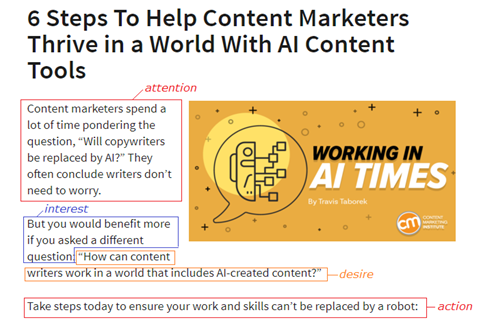
3. Preview, proof, bridge (PPB)
Backlinko’s Brian Dean also uses this formula to engage users from the first sentence and clarify whether the content is worth reading:
- Preview your content asset.
- Provide proof why it’s worth further investigation.
- Add a bridge (a short transition phrase to keep readers glued and get them to the next paragraph).
Brian’s article on blog promotion uses the PPB method:
- Preview: “In today’s post, I’m going to show you exactly how to promote your blog.”
- Proof: “These are the same strategies that I used to grow my blog to 449,058 monthly visits.”
- Bridge: “Let’s dive right in.”

4. Short, pain, yay (SPY)
People don’t want to work hard to understand your content. Don’t frighten them with complicated sentences and long paragraphs in the introduction. Make it visually readable, punchy, and easy to digest.
Start with a short sentence that hooks the audience. How do you know what hooks readers and grabs their attention? Ask an intriguing question. Make a controversial statement. Use a quote or incorporate statistics. Include a surprising fact.
The only rule? Say something that will yay the audience – something unusual and unexpected. Whether you use a question or a statement, make it sound odd enough for readers to crave more. To cement the effect, refer to a pain point your readers might have. Communicate awareness of your targets’ problems, and you’ll gain their sympathy.
The SPY formula includes the following:
- Start with a short
- Address a pain point.
- Hook with a yay info (say something unusual or unexpected).
Helen Boss demonstrates this technique in her article for SmartBlogger:
- Short and yay: “Looking for inspiring ways to use conversion copywriting?”
- Pain point: “… But you’re struggling to understand how to win over visitors quickly before they leave your site. It’s frustrating! And, on top of that, it’s leaving you out of pocket.”
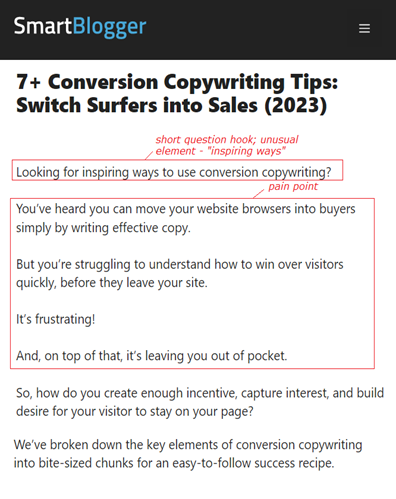
5. Socratic method
I mentioned the Socratic method in my article about neuro writing tactics. Named after the ancient Greek philosopher Socrates, it’s about asking argumentative questions to stimulate curiosity and critical thinking. Perfect to use in content introductions to hook users and create a reading flow.
But it’s not about only asking a question in the first sentence. Use at least two (ideally three) questions in a row. Ensure each is concise and contextually related to the information in the content.
Intro writing tip: Write three concise and contextually related questions in a row, says @WritingBreeze via @CMIContent. #WritingTips Click To Tweet
My writing guru Henneke Duistermaat nails it in the article, How To Turn a Sales Pitch Into a Pleasant Conversation: 3 Writing Techniques:
- “Does writing sales copy feel hard?”
- “Do you feel like you have to turn yourself into a pushy sales person?”
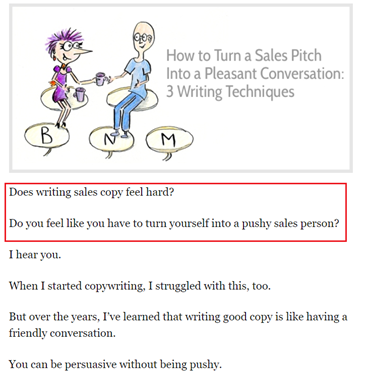
Instead of questions, you can post consecutive statements. Choose those your target readers will nod in agreement as they read. It gives them subconscious proof you understand their pain and know how to help.
Brian Clark uses the Socrates statement method in this Copyblogger article in which he says he will share how to:
- Get started
- Cut the fluff
- Finish a draft.

6. Concise yet emotional
The oldy-moldy powerful technique of storytelling engages readers and makes them want to keep reading. Why? Stories activate the experience-related parts of the brain.
Reading or listening to a story immerses the readers who feel more connected and related to the information shared in the story. It also keeps them wanting to see how the story progresses.
Sharing a personal story – reflective writing – in an introduction involves readers. I use this technique on Writing Breeze sometimes. For example, under the headline SEO Writing: How To Craft Content Google and Searchers Will Love, I write: “First, a confession. I’ve been in SEO writing for 10+ years …”
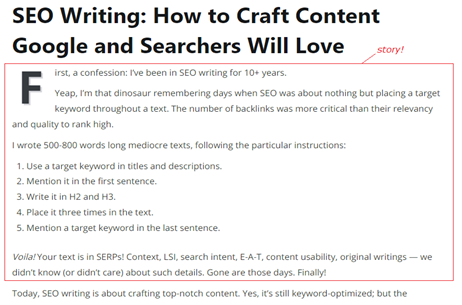
But you don’t have to go personal. You can use the Pinocchios of storytelling – fictional characters to tell a story, create emotional connections, and improve the content experience for your audience. Back to Henneke again in the article, How To Outline a Blog Post (and Create a Hypnotic Flow), who writes:
“Harry is scratching his head. He stares at his draft text, while sipping his coffee. Why does his writing feel like a mess? What is he actually trying to communicate …”
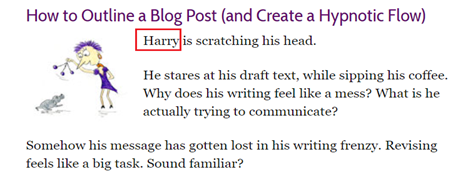
7. Scene-setting
This intro method sets a scene for the readers to prompt their curiosity and help them understand what to expect. It also works well for emerging topics or newsy issues.
With scene-setting, you can:
- Establish a clear position on the issue.
- Highlight the aspects of your content asset.
- Manipulate the reader’s emotions by setting a desired tone from the beginning.
- Address the reader’s imagination and involve them in the process of thinking.
That’s what Lesley Vos does in her article on WordStream:
“There are two magic lands. One is the land of friendly grain-grower tribes, while the other is a motherland of mean-spirited hunters warring and betraying for profit.
“Can you guess which land is called Grataka and which one is called Lamoniana?”
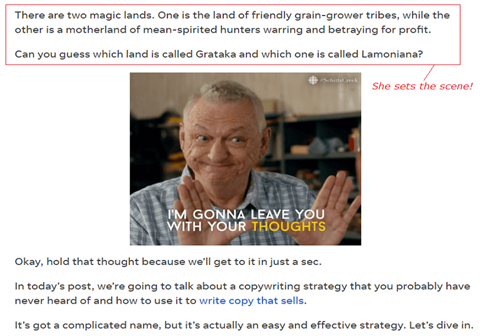
Scene-setting intros appeal to social instinct, evoke curiosity, and motivate people to keep reading to get the answer and disclose if the assumptions were correct. A well-written scene in an introduction also provides background on the topic, so readers can understand why it’s worth their time.
Which intro method motivates you to read?
Introduction writing takes time and practice to master. Formulaic methods from savvy content creators can help but don’t treat them as the ultimate truth: Follow your writing style, brand tone of voice, and target audience’s needs to create opening paragraphs they’ll be eager to read.
After you draft an intro, ask: “Would I read the article if I went through this kind of introduction?” If you answer “yes,” move on to the next paragraphs. If you answer “no” or hesitate, revise it until you’re satisfied.
Remember Hemingway’s advice: “All you have to do is write one true sentence.” Start your introduction with “the truest sentence you know,” and your reader will stay with you.
HANDPICKED RELATED CONTENT:
Cover image by Joseph Kalinowski/Content Marketing Institute
MARKETING
3 Contextual Link-Building Strategies That Actually Work

Quality content can get your web pages ranking higher in Google search results. But contextual links can help, too.
Google says the inclusion of relevant, high-quality links signals the content that includes them may be quality content, too.
So, how can you earn contextual links to give your content an edge over the competition? Adopt one, two, or all three of the strategies detailed in this article.
But first, let’s understand what contextual links are.
What are contextual links?
A contextual link appears in the body of a web page’s content. A hyperlink is added to a relevant word or phrase. They:
- Link to other pages on the site.
- Cite the source of a claim or statistic.
- Indicate other relevant pages.
- Provide readers with more in-depth information on the topic.
- Guide readers to a product or service.
In this screenshot of an article with the header, Challenges of Productivity Tracking in Remote Workplaces, three phrases are hyperlinked — measure productivity, Microsoft, and research by Gartner.
Each contextual link serves a purpose:
- “Measure productivity” goes to a Slack article about how to measure employee productivity.
- “Microsoft” directs the reader to the original research for the cited statistic.
- “Research by Gartner” links to the native source for the research cited in that paragraph.
With a contextual link-building strategy, you not only boost your content in the eyes of Google but also encourage other sites to use your valuable content to provide their readers with additional information or context.
Now, let me show you three strategies to grow your contextual links and improve your content’s rankings.
1. Help sites fix their broken links
Broken link building involves contacting a website, pointing out a broken external link on a page, and suggesting your content as its replacement.
Broken links could result from a 404 error, a blank page, or a redirect to an irrelevant page — any alteration that ruins the original link’s purpose.
Since broken links negatively affect the visitor experience, removing them is in the site’s best interest. Your replacement offer gives them a quick solution to their problem. Plus, people are more willing to help you after you’ve helped them.
To find broken links, use a tool like Free Backlink Checker extension. I also like to inspect links manually since most tools only pick up 404 errors. Rely solely on them, and you will miss relevant broken-link opportunities.
Ahrefs also has tools for finding broken links. Its free broken link checker is helpful, but the paid version is more robust.
Paid subscribers can go to Site Explorer, go to the Outgoing Links report, and click on “Broken Links” from the dropdown menu.
The report identifies the total number of broken links (3,136 in the example below), the referring pages (the URL for the content including the broken link), the anchor (the words hyperlinked in the content), and the link (the URL that no longer directs to a viable page).

Ahrefs subscribers can also compile a Best by Links report under the Pages option in the Site Explorer tool.
In this example, the report lists pages with 404 page-not-found errors for TheMuse.com. It has 6,230 pages with broken external links. Each page URL listed is accompanied by the number of referring domains and a number of links to the page.
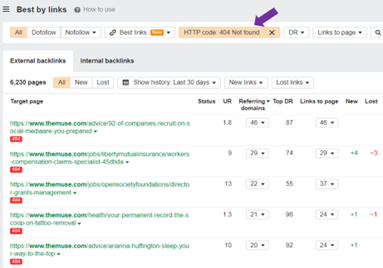
This research can identify the topics with the biggest potential to become the fixes for a broken link. You can create content to address them or identify content you already published. Just make sure the content closely matches the intent of the anchor text’s original link.
For example, the same research report, which is now a broken link, is cited in articles from Oyster and TINYpulse. On Oyster, the anchor text reads, “44% of companies did not allow remote work.” On TINYpulse, the anchor text says, “only 33% are very satisfied with the level of trust in their organization.”
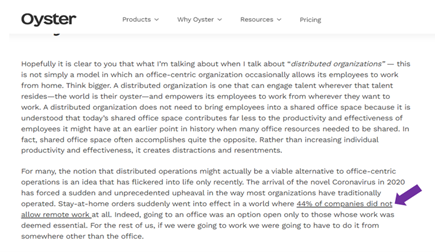
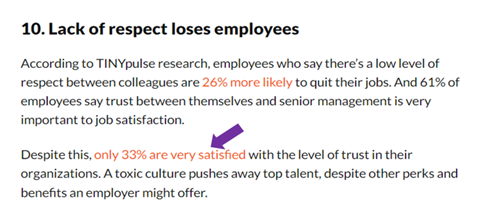
For a single article link to replace the broken link on Oyster and TINYpulse, the content would need to cite both a statistic about remote work and another stat about trust in organizations.
2. Guest posting
Like the broken-link replacement strategy, guest posting benefits both your and the recipient’s sites. You reach out to sites and offer to write content about a topic relevant to their audience that relates to your content subjects and includes a link to your site. This technique works well because you typically control where and how to add your link to make it as relevant as possible.
You can take multiple approaches to win guest-posting opportunities. No matter which tactics you use, track the sites and verify the site’s quality using Ahrefs, another tool, or a direct visit to the site.
First, you can use Ahrefs (or a similar tool) to examine your competitors’ backlinks and identify any links that come from guest posts. The anchor or surrounding text might hint at its status with phrases such as “contributed by,” “guest post by,” or the name of the brand or author. You also can check links manually to see if they’re contributed content.
In this example from Collegiate Parent, the headline reads “EFC Too High? Tips for Successful Aid Appeals” and includes a byline for “Billie Jo Weis.” At this point, you don’t know if it is a contributed article.

But scroll down to the end, and you can see the author’s bio. It confirms the article is a guest post because her bio says she is a client services advisor for My College Planning Team, not the publisher (Collegiate Parent).

You can also use Google search operators to identify sites open to guest contributions. You’ll want to do several searches using variations of your target keywords and topic accompanied by phrases, such as “guest post,” “contributed by,” “guest post by,” and “guest posting guidelines.”
The example in the screenshot below works for a brand targeting college prep topics. The search is “’college prep’ ‘guest post by’ -site.pinterest.com.” The results reveal four articles from four sites that use the words “college prep” and “guest post by.” You can add those sites to your outreach tracker.

Finally, you can list sites relevant to your niche that didn’t appear in the earlier searches.
TIP: Not all sites that accept guest articles say so on their website.
3. Niche edits
A niche edit, sometimes referred to as a link insert, is a technique that adds a link to existing content. The key to success is finding relevant articles on high-quality sites and pitching your content as a valuable addition to those articles.
You can use a similar process to the Google guest post search. Input a broad keyword for your targeted keyword, then tell it you don’t want the targeted keyword in the title. If the entire article is about your targeted keyword, your chances of getting the publisher to include a link to a similar article are low.
Here’s an example from one of our client’s that sought to make niche edits for the keyword “soft skills.”
The Google search included these phrases:
- “Organizational development” soft skills -intitle:”soft skills”
- “Organizational development” soft skills employee training -intitle:”soft skills”
- Soft skills employee training -intitle:”soft skills” organizations
It led to an added link for “soft skills” in this article — “Employee Development,” which includes the header, “What are the benefits of employee development for an organization?”
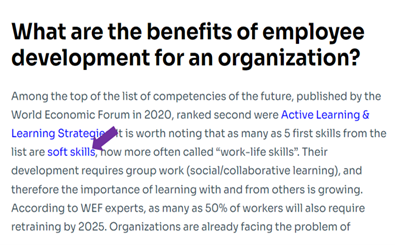
You can do several searches, modifying your search operators each time to see what sites and content appears. Think of multiple angles to broaden the potential sites that publish content with your targeted or a related keyword.
After you’ve crafted a list of high-quality prospects, it’s time for outreach.
Niche edits might be the hardest of the three strategies to achieve because they’re not as clear of a win-win situation as the other two (repairing broken links and publishing new content).
Your email pitch can make or break your niche-edit campaign. It must convince the publisher that your content provides so much value that they will want to take an extra step with content they’ve already completed.
Here are some tips to craft a link-earning email pitch:
- Start by mentioning something about them. It could be something you like about their website or the article you’re targeting. You want them to know you’ve explored their site and read the article. But don’t overdo it. A simple compliment or sentence about how you found the article helpful should suffice.
- Introduce your content and mention how it can help their audience. Be concise and convincing, but don’t oversell it.
- Go one step further and point to a section or sentence where you think your content might be a good fit. This will help them see where your content can add value and link to it.
Get linking
Though contextual link building may seem challenging to execute, it can bring great rewards. Follow these tips and strategies, and your valuable content will get more attention from external sites and eventually Google rankings where it deserves to be.
All tools mentioned in this article are identified by the author. If you have a tool to suggest, please tag CMI on social.
HANDPICKED RELATED CONTENT:
Cover image by Joseph Kalinowski/Content Marketing Institute
MARKETING
Google’s Surgical Strike on Reputation Abuse

These aren’t easy questions. On the one hand, many of these sites do clearly fit Google’s warning and were using their authority and reputation to rank content that is low-relevance to the main site and its visitors. With any punitive action, though, the problem is that the sites ranking below the penalized sites may not be of any higher quality. Is USA Today’s coupon section less useful than the dedicated coupon sites that will take its place from the perspective of searchers? Probably not, especially since the data comes from similar sources.
There is a legitimate question of trust here — searchers are more likely to trust this content if it’s attached to a major brand. If a site is hosting third-party content, such as a coupon marketplace, then they’re essentially lending their brand and credibility to content that they haven’t vetted. This could be seen as an abuse of trust.
In Google’s eyes, I suspect the problem is that this tactic has just spread too far, and they couldn’t continue to ignore it. Unfortunately for the sites that were hit, the penalties were severe and wiped out impacted content. Regardless of how we feel about the outcome, this was not an empty threat, and SEOs need to take Google’s new guidelines seriously.
MARKETING
18 Events and Conferences for Black Entrepreneurs in 2024

Welcome to Breaking the Blueprint — a blog series that dives into the unique business challenges and opportunities of underrepresented business owners and entrepreneurs. Learn how they’ve grown or scaled their businesses, explored entrepreneurial ventures within their companies, or created side hustles, and how their stories can inspire and inform your own success.
It can feel isolating if you’re the only one in the room who looks like you.
-

 MARKETING3 days ago
MARKETING3 days ago18 Events and Conferences for Black Entrepreneurs in 2024
-

 MARKETING5 days ago
MARKETING5 days agoAdvertising on Hulu: Ad Formats, Examples & Tips
-

 WORDPRESS6 days ago
WORDPRESS6 days agoBest WordPress Plugins of All Time: Updated List for 2024
-

 MARKETING6 days ago
MARKETING6 days agoUpdates to data build service for better developer experiences
-

 WORDPRESS6 days ago
WORDPRESS6 days agoShopify Could Be Undervalued Based On A Long-Term Horizon
-

 WORDPRESS4 days ago
WORDPRESS4 days ago5 Must See Telegram Plugins for WooCommerce
-

 PPC6 days ago
PPC6 days agoLow Risk, High Reward YouTube Ads alexking
-

 PPC7 days ago
PPC7 days agoGoogle Shopping: A Beginner’s Guide to Crafting a Compelling Campaign Google Shopping: A Beginner’s Guide to Crafting a Compelling Campaign















